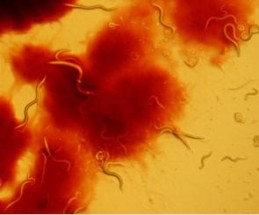Sex and the Red Queen hypothesis
July 12, 2011 by Amara D. Angelica

Roundworm Caenorhabditis elegans vs. the pathogenic bacteria Serratia marcescens (credit: Indiana University)
Biologists at Indiana University have discovered why it takes two to tango. (Insert obligatory geeks-who-can’t-get-a-date joke here.)
The biologists claim their research shows that sex allows parents to produce offspring that are more resistant to co-evolving parasites, while self-fertilization dooms populations to extinction at the hands of their biological enemies.
It’s the Red Queen hypothesis, a reference to Lewis Carroll’s Alice in Wonderland: “It takes all the running you can do, to keep in the same place.”
Biologists learn the facts of life

Off with their heads! (Credit: Walt Disney Pictures)
The hypothesis suggests that sexual reproduction via cross-fertilization keeps host populations one evolutionary step ahead of the parasites, which are frantically co-evolving to infect them.
So both hosts and parasites are running (evolving) as fast as they can just to stay in the same place.
To test the Red Queen Hypothesis, the biologists conducted more than 70 evolution experiments, using the microscopic roundworm Caenorhabditis elegans as a host and the pathogenic bacteria Serratia marcescens to generate a host-parasite co-evolutionary system in a controlled environment. That’s a whole lotta lovin‘ goin’ on.
They found that when the parasite did not co-evolve, self-fertilization evolved as the dominant form of host reproduction. However, when the parasite was allowed to co-evolve with the hosts, sex became the favored reproductive strategy.
Who knew we would thank parasites?
Ref.: Curtis M. Lively, et al., Running with the Red Queen: Host-Parasite Coevolution Selects for Biparental Sex, Science, 2011: Vol. 333 no. 6039 pp. 216-218 [DOI: 10.1126/science.1206360]